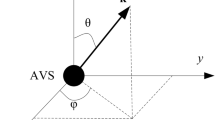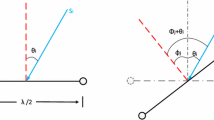Abstract
This paper investigates the direction of arrival (DOA) estimation performance in the presence of polarity inconsistency in uniform acoustic vector sensor (AVS) linear array. We analyze the influence of polarity bias on beampattern directivity of the AVS array. The analysis results show that the polarity bias leads to asymptotically biased estimation. Then, the analytical expression for the asymptotic bias based on classical beamforming is derived in the presence of polarity error. Moreover, to improve the DOA estimation performance in the presence of polarity inconsistency, a polarity calibration method is proposed. Numerical simulations reveal the effectiveness and superiority of the proposed calibration method when the polarity error satisfies with the uniform distribution and the normal distribution.









Similar content being viewed by others
References
Aich, A., & Palanisamy, P. (2017). On-grid DOA estimation method using orthogonal matching pursuit. In IEEE International conference on signal processing and communication, pp. 483–487.
Aktas, M., & Ozkan, H. (2018). Acoustic direction finding using single acoustic vector sensor under high reverberation. Digital Signal Processing, 75, 56–70.
Awad, M. K., & Wong, K. T. (2012). Recursive least-squares source tracking using one acoustic vector sensor. IEEE Transactions on Aerospace and Electronic Systems, 48(4), 3073–3083.
Dassios, I., & Baleanu, D. (2018). Optimal solutions for singular linear systems of caputo fractional differential equations. Mathematical Methods in the Applied Sciences. https://doi.org/10.1002/mma.5410.
Dassios, I. K. (2019). Analytic loss minimization: Theoretical framework of a second order optimization method. Symmetry, 11(2), 136.
Dassios, I., Fountoulakis, K., & Gondzio, J. (2015). A preconditioner for a primal-dual newton conjugate gradient method for compressed sensing problems. SIAM Journal on Scientific Computing, 37(6), A2783–A2812.
De-sen, S. J. Y. (2010). Localization of underwater noise sources based on broadband MVDR focused beamforming with vector sensor array processing. Signal Processing, 5, 009.
Fauziya, F., Lall, B., & Agrawal, M. (2018). Impact of vector sensor on underwater acoustic communications system. IET Radar, Sonar and Navigation, 12(12), 1500–1508.
Guo, L., Han, X., Yin, J., & Yu, X. (2018). Underwater acoustic communication by a single-vector sensor: Performance comparison using three different algorithms. Shock and Vibration. https://doi.org/10.1155/2018/2510378.
Han, K., & Nehorai, A. (2014). Nested vector-sensor array processing via tensor modeling. IEEE Transactions on Signal Processing, 62(10), 2542–2553.
Hawkes, M., & Nehorai, A. (1998). Acoustic vector-sensor beamforming and capon direction estimation. IEEE Transactions on Signal Processing, 46(9), 2291–2304.
Hawkes, M., & Nehorai, A. (2001). Acoustic vector-sensor correlations in ambient noise. IEEE Journal of Oceanic Engineering, 26(3), 337–347.
Jin, H., Jiang, S., Wang, J., & Zhong, L. (2010). Particle-velocity-field difference smoothing for coherent source localization in spatially nonuniform noise. IEEE Journal of Oceanic Engineering, 35(1), 113–119.
Kitchens, J. P. (2008). Acoustic vector-sensor array performance. Ph.D. dissertation, Massachusetts Institute of Technology.
Krishnaprasad, N. (2016). Acoustic vector sensor based source localization. Ph.D. dissertation, Delft University of Technology.
Le Bihan, N., Miron, S., & Mars, J. I. (2007). Music algorithm for vector-sensors array using biquaternions. IEEE Transactions on Signal Processing, 55(9), 4523–4533.
Ma, L., Gulliver, T. A., Zhao, A., Ge, C., & Bi, X. (2019). Underwater broadband source detection using an acoustic vector sensor with an adaptive passive matched filter. Applied Acoustics, 148, 162–174.
Malioutov, D., Cetin, M., & Willsky, A. S. (2005). A sparse signal reconstruction perspective for source localization with sensor arrays. IEEE Transactions on Signal Processing, 53(8), 3010–3022.
Miron, S., Le Bihan, N., & Mars, J. I. (2006). Quaternion-music for vector-sensor array processing. IEEE Transactions on Signal Processing, 54(4), 1218–1229.
Najeem, S., Kiran, K., Malarkodi, A., & Latha, G. (2017). Open lake experiment for direction of arrival estimation using acoustic vector sensor array. Applied Acoustics, 119, 94–100.
Nehorai, A., & Paldi, E. (1994). Acoustic vector-sensor array processing. IEEE Transactions on Signal Processing, 42(9), 2481–2491.
Ramamohan, K. N., Comesaña, D. F., & Leus, G. (2018). Uniaxial acoustic vector sensors for direction-of-arrival estimation. Journal of Sound and Vibration, 437, 276–291.
Santos, P., Rodriguez, O., Felisberto, P., & Jesus, S. (2010). Seabed geoacoustic characterization with a vector sensor array. The Journal of the Acoustical Society of America, 128(5), 2652–2663.
Shi, S., Li, Y., Zhu, Z., & Shi, J. (2019). Real-valued robust doa estimation method for uniform circular acoustic vector sensor arrays based on worst-case performance optimization. Applied Acoustics, 148, 495–502.
Tao, J., Chang, W., & Shi, Y. (2008). Direction-finding of coherent sources via ‘particle-velocity-field smoothing. IET Radar, Sonar and Navigation, 2(2), 127–134.
Tichavsky, P., Wong, K. T., & Zoltowski, M. D. (2001). Near-field/far-field azimuth and elevation angle estimation using a single vector hydrophone. IEEE Transactions on Signal Processing, 49(11), 2498–2510.
Tropp, J. A., Gilbert, A. C., & Strauss, M. J. (2006). Algorithms for simultaneous sparse approximation. Part i: Greedy pursuit. Signal Processing, 86(3), 572–588.
Xiaofei, Z., Ming, Z., Han, C., & Jianfeng, L. (2014). Two-dimensional doa estimation for acoustic vector-sensor array using a successive music. Multidimensional Systems and Signal Processing, 25(3), 583–600.
Zhang, L., Wu, D., Han, X., & Zhu, Z. (2016). Feature extraction of underwater target signal using mel frequency cepstrum coefficients based on acoustic vector sensor. Journal of Sensors. https://doi.org/10.1155/2016/7864213.
Zhang, Q., Abeida, H., Xue, M., Rowe, W., & Li, J. (2012). Fast implementation of sparse iterative covariance-based estimation for source localization. The Journal of the Acoustical Society of America, 131(2), 1249–1259.
Zhang, Z., He, J., Shu, T., & Yu, W. (2018). Successive method for angle-polarization estimation with vector-sensor array. IEEE Sensors Letters, 2(1), 1–4.
Zhao, A., Ma, L., Hui, J., Zeng, C., & Bi, X. (2018). Open-lake experimental investigation of azimuth angle estimation using a single acoustic vector sensor. Journal of Sensors. https://doi.org/10.1155/2018/4324902.
Zoltowski, M. D., & Wong, K. T. (2000). Esprit-based 2-d direction finding with a sparse uniform array of electromagnetic vector sensors. IEEE Transactions on Signal Processing, 48(8), 2195–2204.
Zou, Y. X., Li, B., & Ritz, C. H. (2016). Multi-source doa estimation using an acoustic vector sensor array under a spatial sparse representation framework. Circuits Systems and Signal Processing, 35(3), 993–1020.
Acknowledgements
This work was supported by the National Key R&D Program of China under Grant 2016YFC1400203, National Natural Science Foundation of China under Grants 61531015, 61501374, 61771394 and Natural Science Basic Research Plan in Shaanxi Province of China under Grant 2018JM6042.
Author information
Authors and Affiliations
Corresponding author
Additional information
Publisher's Note
Springer Nature remains neutral with regard to jurisdictional claims in published maps and institutional affiliations.
Appendix A
Appendix A
Here, we derive the bias expression of (27) in Sect. 4. By taking the first and second order derivatives of \(f(\theta )\) with respect to \(\theta \), we obtain
By substituting (68) and (69) for (26), we can get
where \( {\hat{{\varvec{ R}}}} = \sigma _s^2{{\varvec{ a}}}(\theta ,{{\varvec{\beta }}} ){{{\varvec{ a}}}^H}(\theta ,{{\varvec{\beta }}}) + \sigma _n^2{{\varvec{ I}}}\). By calculating \(\dfrac{{\partial {{{\varvec{ A}}}^H}(\theta )}}{{\partial \theta }}\) and \(\dfrac{{{\partial ^2}{{{\varvec{ A}}}^H}(\theta )}}{{\partial {\theta ^2}}} \), we can get
where \({a'}_{mp}(\theta )\) and \({a''}_{mp}(\theta )\) represent the first derivative and the second derivative of \({a_{mp}}(\theta )\) with respect to \(\theta \), respectively.
In order to compute the analytic expression of \({\hat{b}}({\theta })\), we also need to compute the following inner product.
Rights and permissions
About this article
Cite this article
Wang, W., Zhang, Q., Shi, W. et al. Performance analysis and DOA estimation method over acoustic vector sensor array in the presence of polarity inconsistency. Multidim Syst Sign Process 31, 1341–1364 (2020). https://doi.org/10.1007/s11045-020-00712-5
Received:
Revised:
Accepted:
Published:
Issue Date:
DOI: https://doi.org/10.1007/s11045-020-00712-5




